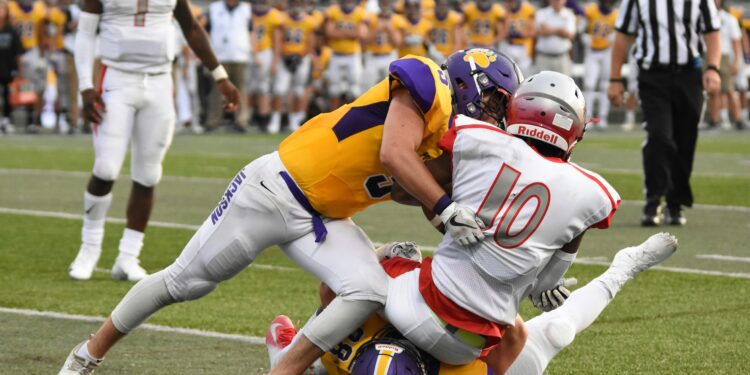Football is a sport that combines skill, strategy, and raw physical strength. From an outsider’s perspective, it may seem like a simple game of players tackling each other. However, beneath the surface, the force of impact during a tackle can be truly astonishing and potentially dangerous.
Players collide with each other during tackles, and the force of these impacts can be quite significant. Understanding the force of impact that occurs during a tackle is crucial for both player safety and field design.
To measure the force of impact, researchers use a metric called G-Max. G-Max rates a field’s shock absorbency by dropping an object that approximates a human head and neck from a height of 2 feet. The object is about 20 square inches and weighs around 20 pounds. A low G-Max means that the field absorbs more energy than the player, thus enhancing healthcare safety protocols in sports environments.
This metric quantifies the amount of energy absorbed by the field when an object, resembling a human head and neck, is dropped from a height of 2 feet. A lower G-Max value indicates better shock absorbency. For instance, synthetic surfaces can reach up to 120.
In Philadelphia’s new stadium, which has a grass field, the G-Max rating is just over 60. This means that the field absorbs a significant amount of energy during a tackle. In contrast, synthetic surfaces can have G-Max ratings of up to 120, indicating a higher impact force on the players.
However, the hardest turf for players is frozen grass. The frozen ground offers little shock absorbency, leading to higher forces of impact during tackles. Players on frozen grass may experience more severe collisions and a greater risk of injury. This emphasizes the role of environmental factors in football and the need for healthcare policy improvements in sports field standards to ensure athlete safety.
This distinction highlights the significance of environmental factors in football. The harder the surface, the greater the force of impact on a player’s body, making tackling on frozen grass particularly brutal. These conditions can place additional stress on the players, potentially leading to more severe injuries.
But just how much force is generated during a tackle? To calculate this, we need to consider the mass, acceleration, and time interval over which the change in speed occurs. When these factors are taken into account, the backward deceleration during a tackle is around minus 240 feet per second squared. This means that the force experienced is equivalent to approximately 1,650 pounds, or about three-fourths of a ton. To put this into perspective, it is comparable to the weight of a baby whale.
If you still find it challenging to visualize the force of an NFL tackle, imagine being slammed into by a young orca face first at Sea World. The impact of such a collision is undoubtedly powerful and can give you a sense of the force football players experience during tackles.
To further illustrate the intensity of a tackle, let’s consider helmet-to-helmet collisions. These types of hits are sometimes against the rules, but they do occur on occasion. When two players collide helmet to helmet, it is estimated to be similar to having a 16-pound bowling ball dropped on your head from a height of 12 feet. The impact from such a collision can cause severe damage and increase the risk of traumatic brain injuries.
To understand the sheer force in a tackle, one must consider the principles of physics. Using Newton’s second law of motion, force can be calculated by multiplying mass by acceleration and dividing it by the time interval over which the speed changes. As a result, the backward deceleration experienced can reach a staggering – 240 feet per second squared.
Although helmet-to-helmet collisions are often penalized in football due to the risk of head injuries, they nonetheless occur with alarming frequency. When such collisions happen, one can only imagine the destructive forces involved.
Players subject their bodies to tremendous forces as they collide with opponents. From the G-Max ratings of different playing surfaces to the calculation of force using Newton’s laws of motion, it is evident that the physical toll on football players is immense. Understanding the intensity of these impacts should not only raise awareness about the potential risks involved but also emphasize the importance of proper training, protective equipment, and ongoing research to minimize injuries in this immensely popular sport.
As the sport continues to evolve, efforts must be made to strike a balance between maintaining the physicality of the game and ensuring the well-being of the athletes involved, aligning with the goals of healthcare management and modern medical practices in sports.















